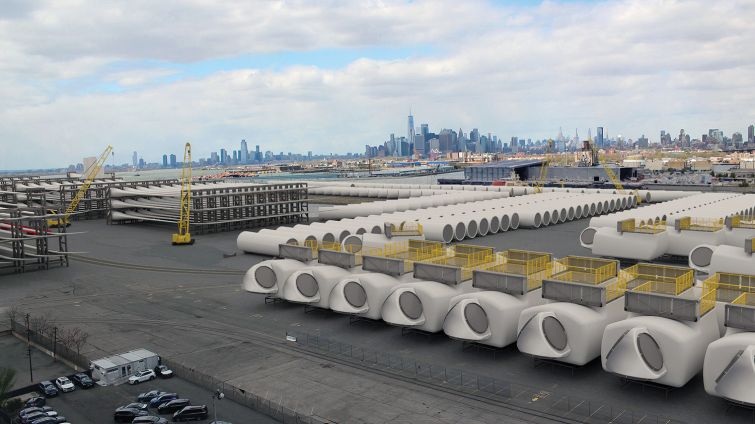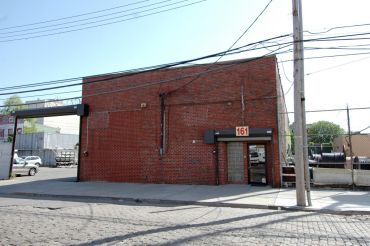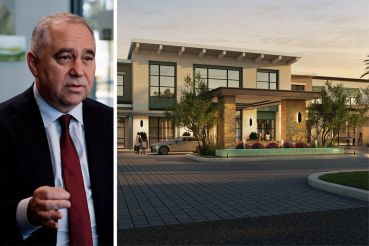How Brooklyn’s ‘Innovation Coast’ Became a Self-Fulfilling Prophecy
The nickname was really just a marketing ploy for a stretch of neighborhoods, but it's drawn dozens of businesses and billions in investment
By Rebecca Baird-Remba January 29, 2024 8:30 am
reprints
Seven years ago, a group of developers debuted a marketing campaign aimed at attracting Amazon to Brooklyn, dubbing the stretch of East River waterfront from Williamsburg to Sunset Park the “Innovation Coast.” Over the past few years, the New York City Economic Development Corporation has reconfigured the concept into a less cringeworthy set of environmentally friendly incubator programs based in Brooklyn.
Then, last week in his State of the City speech, Mayor Eric Adams unveiled a similar “Harbor of the Future” plan that includes $100 million for climate-tech startups at Brooklyn Army Terminal (BAT), a climate research hub on Governors Island, new green energy startup spaces at the Brooklyn Navy Yard, and a planned life sciences campus in Manhattan’s Kips Bay.
“The same harbor that has welcomed immigrants in the past will be a place of even more opportunity going forward,” the mayor said Jan. 24. “We are transforming the waterfronts and shorelines that first made New York the economic engine of this nation into the Harbor of the Future. Over the coming years, the Harbor of the Future will create 53,000 temporary and permanent jobs, generate $95 billion in economic impact, and establish New York City as the global destination for green technology, innovation and opportunity.”
The EDC’s recent “green economy” efforts include a grant program for mass timber construction, those climate tech hubs at the Brooklyn Army Terminal and the Brooklyn Navy Yard, and an offshore wind project accelerator headquartered in Industry City, among others. The Adams administration and the economic development agency also plan to put out a “Green Economy Action Plan” in the coming weeks, which the mayor said would help create 400,000 jobs by the year 2040.
While the city has spent years trying to nurture companies selling energy-efficient tech for buildings, the push for offshore wind development and similar kinds of technology is somewhat newer. Much of this development ties into state-level efforts to decarbonize the electric grid and reduce its reliance on burning natural gas for electricity, as well as the city’s Local Law 97, which requires building owners to reduce carbon emissions 80 percent by 2050.
There’s a good reason why the South Brooklyn waterfront neighborhood of Sunset Park — where Industry City and Brooklyn Army Terminal are both located — has become a hub for climate tech development. Norwegian state-owned energy company Equinor signed a deal to reactivate the vacant South Brooklyn Marine Terminal in March 2022 and turn the large, waterfront industrial property in Sunset Park into a staging and maintenance area for wind farms off the coast of New Jersey and Long Island.
Equinor’s first project, Empire Wind 1, is scheduled to come online in 2026, according to the energy company, and its second offshore wind farm, Beacon Wind, is expected to start spinning 60 miles east of Montauk in 2028. Construction is supposed to start at the Marine Terminal in the next few months, Equinor said in a recent newsletter.
Conveniently, the Marine Terminal is across the street from Industry City and a little more than a mile north of the Brooklyn Army Terminal. Equinor is also funding the Offshore Wind Innovation Hub at Industry City, which helps provide advice and office space for startups hoping to capitalize on the current boom. The first cohort of the outfit’s startup accelerator encompasses companies like Benchmark Labs, which employs weather forecasting tech with artificial intelligence; offshore wind monitoring outfit Flucto; engineering firm Hereema; and a virtual reality simulator geared toward training offshore wind installers called VinciVR.
Equinor has also recently announced a new call for companies to join its offshore wind accelerator, with a deadline of March 25. Businesses and entrepreneurs interested in the offshore wind industry can also apply to join the hub for free, which gives them access to the group’s office space and events.
“I actually don’t think people can comprehend yet how big of an industry it’s going to be,” said Tone Søndergaard, director of the Offshore Wind Innovation Hub. “But, essentially, offshore wind is the biggest industry in the area where I grew up in Denmark. It’s part of everything. I think there’s massive amounts of opportunities for the local community to be engaged in this. The industry seems like it’s just huge companies that are part of it, but once the turbines start rolling in, it becomes incredibly tangible how big of a project is. They’re the biggest pieces of machinery that humans have created — they’re 800 feet tall.”
Before the turbines arrive at the South Brooklyn Marine Terminal in 2026, she explained that Equinor will need to fortify the pier, construct maintenance and assembly buildings and upgrade the electrical systems on the property. The machines are so large that they have to be brought in by ship — typically in smaller pieces — from a nearby manufacturing facility.
A little farther south at the Brooklyn Army Terminal, EDC launched a pilot program for climate-tech companies last year that has already started to bear fruit. The first group of companies includes Conservation Labs, which is developing a monitoring system for plumbing and water use; Enertiv, which uses sensors and digitized electrical meters to track energy use; and Trakref, which monitors refrigerant lines and heating and cooling systems for leaks and energy usage. Electric vehicle charging company Itselectric has also installed curbside charging stations at BAT and the Brooklyn Navy Yard as part of the pilot.
“Whether you’re an entrepreneur or a larger business, you can take part in these conversations and see where you fit in,” said Dina Rabiner, a vice president for economic development at the Brooklyn Chamber of Commerce. Her organization helps recommend businesses for the climate tech accelerators, and it works with job seekers to connect them with gigs in the offshore wind construction industry. She pointed out that the chamber had recently hosted a job fair where many of the employers were in the clean energy industry, including Skanska and Community Offshore Wind, the latter of which is a joint project from National Grid.
A similar crop of sustainable startups is bubbling up at Newlab in the Brooklyn Navy Yard, largely focused on electric vehicles, renewable energy storage, and electric heating and cooling. At the end of 2022, Newlab and the city announced their first crop of startups for the Resilient Energy Studio, though Newlab has since fostered and invested in many similar ones. Those companies include Urban Electric Power, which is developing rechargeable alkaline batteries; Wattmore, a software platform focused on monitoring energy storage systems; solar power storage manufacturer Yotta Energy; and ElectricFish, an electric vehicle charging company that developed a unique energy storage system for fast-charging cars.
Newlab, a venture capital company, both manages an 84,000-square-foot coworking operation at the Navy Yard and invests in many of its tenants. The space has science labs, 3D printers, and other equipment that its 120 New York-based member companies need. Satish Rao, its chief product officer, said he is particularly excited about bidirectional electric vehicle charging, a technology that both Electricfish and another Newlab tenant, Fermata, are working on. Electricfish had already installed one of its chargers at Floyd Bennett Field in southern Brooklyn, and it had been profitable for the city.
“When a car plugs into a bidirectional charger, the car can draw power to charge, or the building [where the charger is installed] can take power from the car,” explained Rao. “We had a car plugged into the bidirectional battery, and with the Fermata software, the building is able to decide if it’s cheaper to take charge from the car or from the utility. Instead of paying the utility, you pay me [the property owner].
“We think the city has the opportunity to really innovate,” he added. “We’re seeing great technologies that can provide the resilient energy that communities need. We think that they’re the future, and our vision is to really help them scale, especially in New York.”
Rebecca Baird-Remba can be reached at rbairdremba@commercialobserver.com.


